Optimal Power Flow for Unbalanced Three-Phase Microgrids Using an Interior Point Optimizer
Abstract
:1. Introduction
2. Background
2.1. Microgrid Components
- Current source inverters maintain a constant power output regardless of the voltage level at the point of common coupling (PCC). This type of inverter functions similar to traditional power generation units.
- Voltage source inverters regulate both the system frequency and PCC voltage, acting as stabilizing agents in microgrid operation.
- Current source grid-supporting inverters share similarities with current source inverters in regulating their constant power output. However, their active and reactive power can be adjusted based on the system frequency and PCC voltages to support the grid.
- Voltage source grid-supporting inverters regulate the PCC voltage and frequency, resembling voltage source inverters. However, their setpoints are adjusted depending on their supplied active and reactive power.
2.2. Microgrid Steady State Modeling and Analysis: Power Flow and Optimal Power Flow
3. OPF Modeling Framework
- OpenDSS [20] is open-source software for simulating and analyzing electrical distribution systems. It is used to model microgrids and their components, such as transformers, lines, capacitors, distributed generators, and loads. Its extensive libraries provide modeling flexibility and facilitate fast development.
- Pyomo [21,22] is an open-source Python package that provides a wide range of optimization tools for formulating and analyzing models. Its application of symbolic definitions and multi-dimensional parameters and variables offers flexibility in modeling. Additionally, Pyomo provides an interface prompt of various solvers like Gurobi, IPOPT, and BONMIN to conveniently solve the formulated problem. In this modeling framework, Pyomo is employed to implement the OPF formulation. This formulation encompasses an objective function and constraints for modeling the microgrid network, its electrical components, and the operating requirements.
- Interior Point Optimizer (IPOPT) [23] is an open-source software package designed for nonlinear optimization. This solver is adopted in this modeling and analysis framework for its robustness. The objectives and constraints can be linear or nonlinear and convex or non-convex.
4. OPF Modeling and Formulation
4.1. Nomenclature
4.2. Microgrid Network
4.3. Grid-Forming Inverter-Based Resource
4.3.1. Single-Phase Grid-Forming Inverter-Based Resource
4.3.2. Three-Phase Grid-Forming Inverter-Based Resource
4.4. Grid-Following Inverter-Based Resource
4.4.1. Single-Phase Grid-Following Inverter-Based Resource
- and : the power injection of the GFL is limited to the minimum kW rating when the power calculated from the droop control is less than the minimum kW limit ().
- and : this solution set describes the scenario where the GFL power is set to the droop power calculation when the calculated droop power is greater than the minimum kW limit.
4.4.2. Three-Phase Grid-Following Inverter-Based Resource
4.5. BESS State of Charge
4.6. Operational Constraints
4.7. Objective
4.8. OPF Formulation
5. Demonstration I: A Single-Phase Three-Bus Islanded Microgrid
5.1. Microgrid Details
5.2. Verification of the OPF Modeling Framework
5.3. Studied Scenarios
5.3.1. Scenario I: PF Analysis of Various GFL Models
5.3.2. Scenario II: PF Analysis of Various GFM Models
5.3.3. Scenario III: QSTS PF and OPF Analyses
5.4. Discussion
6. Demonstration II: Three-Phase Four-Bus Islanded Microgrid
6.1. Microgrid Model
6.2. Results and Discussion
7. Conclusions
Author Contributions
Funding
Institutional Review Board Statement
Informed Consent Statement
Data Availability Statement
Conflicts of Interest
Abbreviations
| BESS | Battery energy storage system |
| BPSC | Balanced positive sequence control |
| FB | Fischer–Burmeister |
| GFL | Grid-following inverter |
| GFM | Grid-forming inverter |
| IBR | Inverter-based resource |
| NLP | Nonlinear programming problem |
| OPF | Optimal power flow |
| PCC | Point of common coupling |
| PDE | Power delivery elements |
| PF | Power flow |
| PNSC | Positive negative sequence compensation |
| PV | Photovoltaic panel |
| QC | Quadratic convex |
| QSTS | Quasi-static time series |
| SDP | Semidefinite programming |
| SoC | State of charge |
| SOCP | Second-order cone programming |
References
- Erseghe, T.; Tomasin, S. Power Flow Optimization for Smart Microgrids by SDP Relaxation on Linear Networks. IEEE Trans. Smart Grid 2013, 4, 751–762. [Google Scholar] [CrossRef]
- Chen, Y.; Xiang, J.; Li, Y. SOCP Relaxations of Optimal Power Flow Problem Considering Current Margins in Radial Networks. Energies 2018, 11, 3164. [Google Scholar] [CrossRef]
- Dvijotham, K.; Molzahn, D.K. Error bounds on the DC power flow approximation: A convex relaxation approach. In Proceedings of the 2016 IEEE 55th Conference on Decision and Control (CDC), Las Vegas, NV, USA, 12–14 December 2016; pp. 2411–2418. [Google Scholar] [CrossRef]
- Claeys, S.; Geth, F.; Deconinck, G. Optimal Power Flow in Four-Wire Distribution Networks: Formulation and Benchmarking. Electr. Power Syst. Res. 2022, 213, 108522. [Google Scholar] [CrossRef]
- Louca, R.; Seiler, P.; Bitar, E. Nondegeneracy and Inexactness of Semidefinite Relaxations of Optimal Power Flow. arXiv 2014, arXiv:1411.4663. [Google Scholar]
- Venzke, A.; Chatzivasileiadis, S.; Molzahn, D.K. Inexact Convex Relaxations for AC Optimal Power Flow: Towards AC Feasibility. Electr. Power Syst. Res. 2020, 187, 106480. [Google Scholar] [CrossRef]
- Sortomme, E.; El-Sharkawi, M.A. Optimal Power Flow for a System of Microgrids with Controllable Loads and Battery Storage. In Proceedings of the 2009 IEEE/PES Power Systems Conference and Exposition, Seattle, WA, USA, 15–18 March 2009; pp. 1–5. [Google Scholar] [CrossRef]
- Martínez-Ramos, J.L.; Marano-Marcolini, A.; García-López, F.P.; Almagro-Yravedra, F.; Onen, A.; Yoldas, Y.; Khiat, M.; Ghomri, L.; Fragale, N. Provision of Ancillary Services by a Smart Microgrid: An OPF Approach. In Proceedings of the 2018 International Conference on Smart Energy Systems and Technologies (SEST), Seville, Spain, 10–12 September 2018; pp. 1–6. [Google Scholar] [CrossRef]
- You, S.; Peng, Q. A Non-Convex Alternating Direction Method of Multipliers Heuristic for Optimal Power Flow. In Proceedings of the 2014 IEEE International Conference on Smart Grid Communications (SmartGridComm), Venice, Italy, 3–6 November 2014; pp. 788–793. [Google Scholar] [CrossRef]
- Chen, T.; Song, Y.; Hill, D.J.; Lam, A.Y.S. Chance-Constrained OPF in Droop-Controlled Microgrids with Power Flow Routers. IEEE Trans. Smart Grid 2022, 13, 2601–2613. [Google Scholar] [CrossRef]
- Li, C.; Chaudhary, S.K.; Savaghebi, M.; Vasquez, J.C.; Guerrero, J.M. Power Flow Analysis for Low-Voltage AC and DC Microgrids Considering Droop Control and Virtual Impedance. IEEE Trans. Smart Grid 2017, 8, 2754–2764. [Google Scholar] [CrossRef]
- Zhao, J.; Chiang, H.D.; Li, H.; Ju, P. On PV-PQ Bus Type Switching Logic in Power Flow Computation. In Proceedings of the Power System Computations Conference (PSCC), Glasgow, UK, 14–18 July 2008. [Google Scholar]
- Zeng, L.; Chiang, H.D.; Neves, L.S.; Alberto, L.F.C. On the accuracy of power flow and load margin calculation caused by incorrect logical PV/PQ switching: Analytics and improved methods. Int. J. Electr. Power Energy Syst. 2023, 147, 108905. [Google Scholar] [CrossRef]
- Liu, G.; Starke, M.; Zhang, X.; Tomsovic, K. A MILP-based distribution optimal power flow model for microgrid operation. In Proceedings of the 2016 IEEE Power and Energy Society General Meeting (PESGM), Boston, MA, USA, 17–21 July 2016; pp. 1–5. [Google Scholar] [CrossRef]
- Rahmani-Andebili, M. Grid-Connected and Off-Grid Operation of a Microgrid Applying Fuzzy Mixed-Integer Linear Programming. In Proceedings of the 2022 IEEE Power and Energy Conference at Illinois (PECI), Champaign, IL, USA, 10–11 March 2022; pp. 1–5. [Google Scholar] [CrossRef]
- Rosehart, W.; Roman, C.; Schellenberg, A. Optimal Power Flow with Complementarity Constraints. In Proceedings of the 2006 IEEE PES Power Systems Conference and Exposition, Atlanta, GA, USA, 29 October–1 November 2006; p. 417. [Google Scholar] [CrossRef]
- Diaz, G.; Gonzalez-Moran, C. Fischer-Burmeister-Based Method for Calculating Equilibrium Points of Droop-Regulated Microgrids. IEEE Trans. Power Syst. 2012, 27, 959–967. [Google Scholar] [CrossRef]
- Tong, X.; Lin, M. Semismooth Newton-Type Algorithms for Solving Optimal Power Flow Problems. In Proceedings of the 2005 IEEE/PES Transmission & Distribution Conference & Exposition: Asia and Pacific, Dalian, China, 18 August 2005; pp. 1–7. [Google Scholar] [CrossRef]
- Rocabert, J.; Luna, A.; Blaabjerg, F.; Rodríguez, P. Control of Power Converters in AC Microgrids. IEEE Trans. Power Electron. 2012, 27, 4734–4749. [Google Scholar] [CrossRef]
- Montenegro, D.; Hernandez, M.; Ramos, G.A. Real time OpenDSS framework for distribution systems simulation and analysis. In Proceedings of the 2012 Sixth IEEE/PES Transmission and Distribution: Latin America Conference and Exposition (T&D-LA), Montevideo, Uruguay, 3–5 September 2012; pp. 1–5. [Google Scholar] [CrossRef]
- Bynum, M.L.; Hackebeil, G.A.; Hart, W.E.; Laird, C.D.; Nicholson, B.L.; Siirola, J.D.; Watson, J.P.; Woodruff, D.L. Pyomo–Optimization Modeling in Python, 3rd ed.; Springer Science & Business Media: Berlin/Heidelberg, Germany, 2021; Volume 67. [Google Scholar]
- Hart, W.E.; Watson, J.P.; Woodruff, D.L. Pyomo: Modeling and solving mathematical programs in Python. Math. Program. Comput. 2011, 3, 219–260. [Google Scholar] [CrossRef]
- Wächter, A.; Biegler, L. On the Implementation of an Interior-Point Filter Line-Search Algorithm for Large-Scale Nonlinear Programming. Math. Program. 2006, 106, 25–57. [Google Scholar] [CrossRef]
- Liao-McPherson, D.; Huang, M.; Kolmanovsky, I. A Regularized and Smoothed Fischer–Burmeister Method for Quadratic Programming With Applications to Model Predictive Control. IEEE Trans. Autom. Control 2019, 64, 2937–2944. [Google Scholar] [CrossRef]
- Zarei, S.F.; Mokhtari, H.; Ghasemi, M.A.; Peyghami, S.; Davari, P.; Blaabjerg, F. Control of Grid-Following Inverters under Unbalanced Grid Conditions. IEEE Trans. Energy Convers. 2020, 35, 184–192. [Google Scholar] [CrossRef]
- Cunha, V.C.; Kim, T.; Barry, N.; Siratarnsophon, P.; Santoso, S.; Freitas, W.; Ramasubramanian, D.; Dugan, R.C. Generalized Formulation of Steady-State Equivalent Circuit Models of Grid-Forming Inverters. IEEE Open Access J. Power Energy 2021, 8, 352–364. [Google Scholar] [CrossRef]

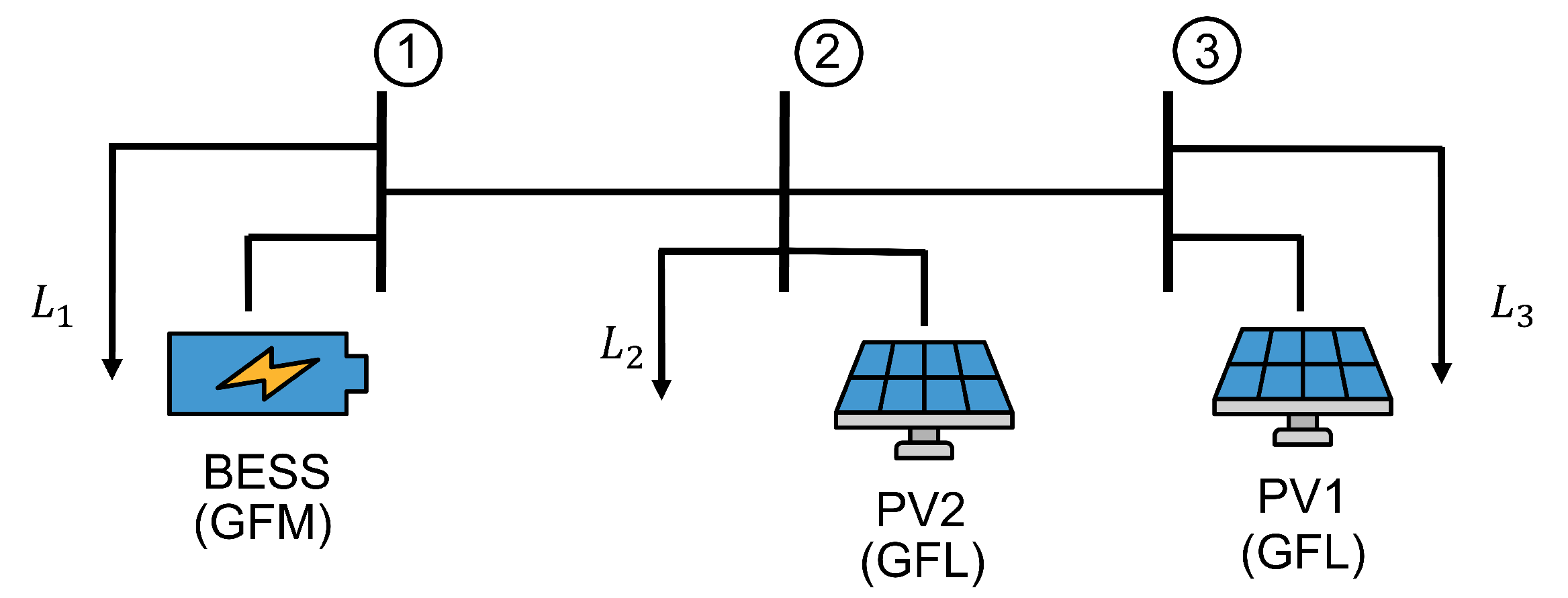
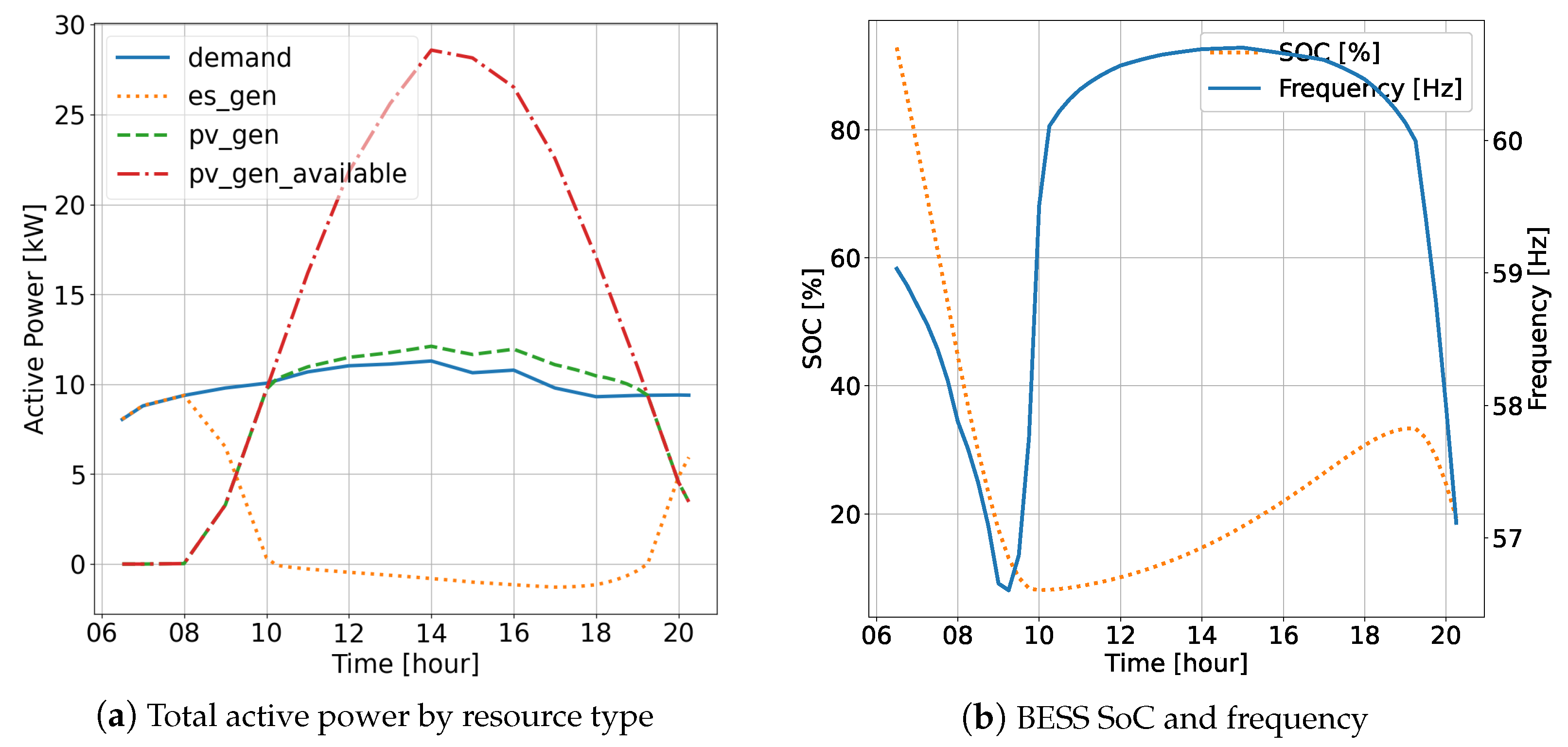
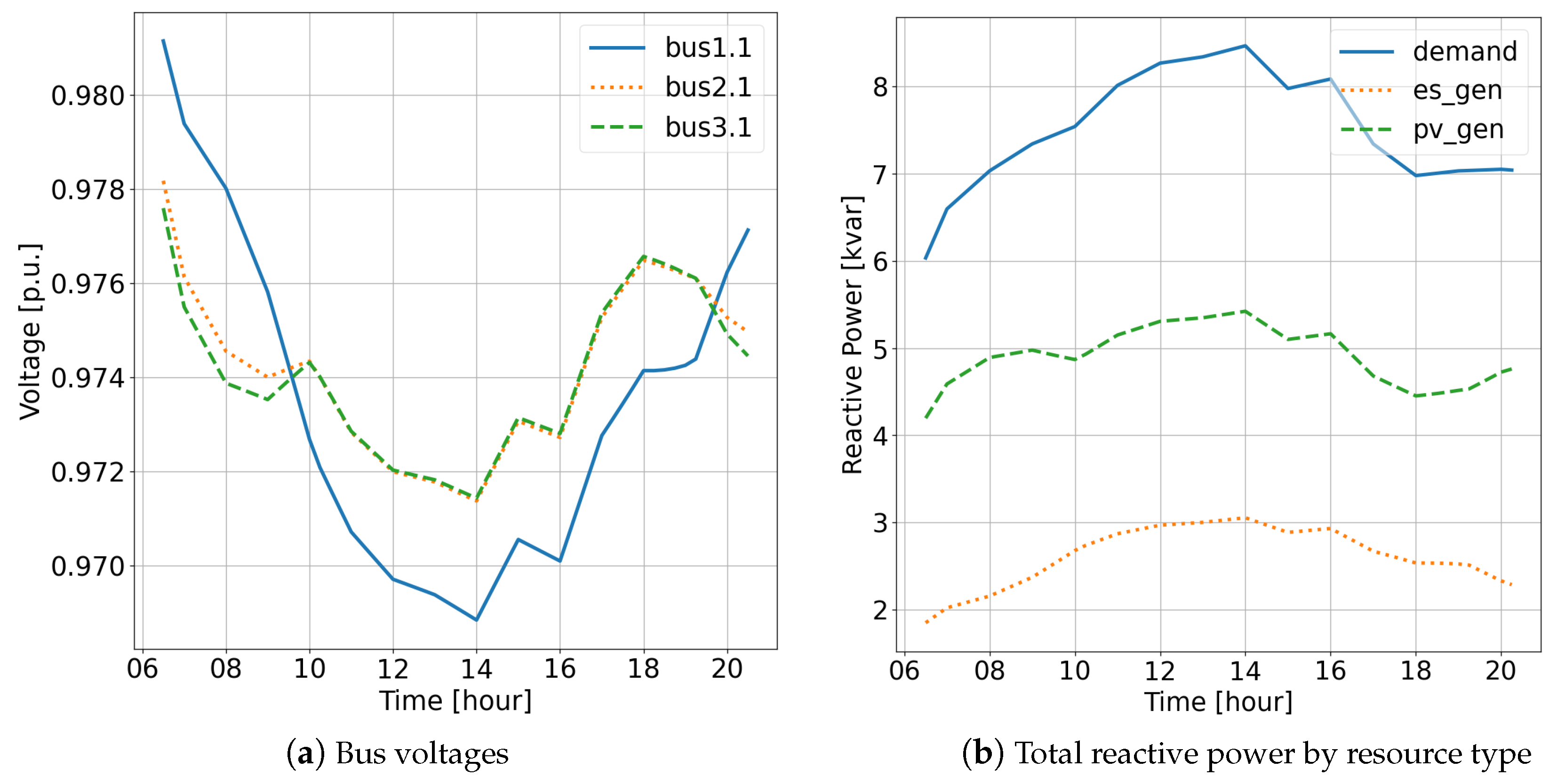
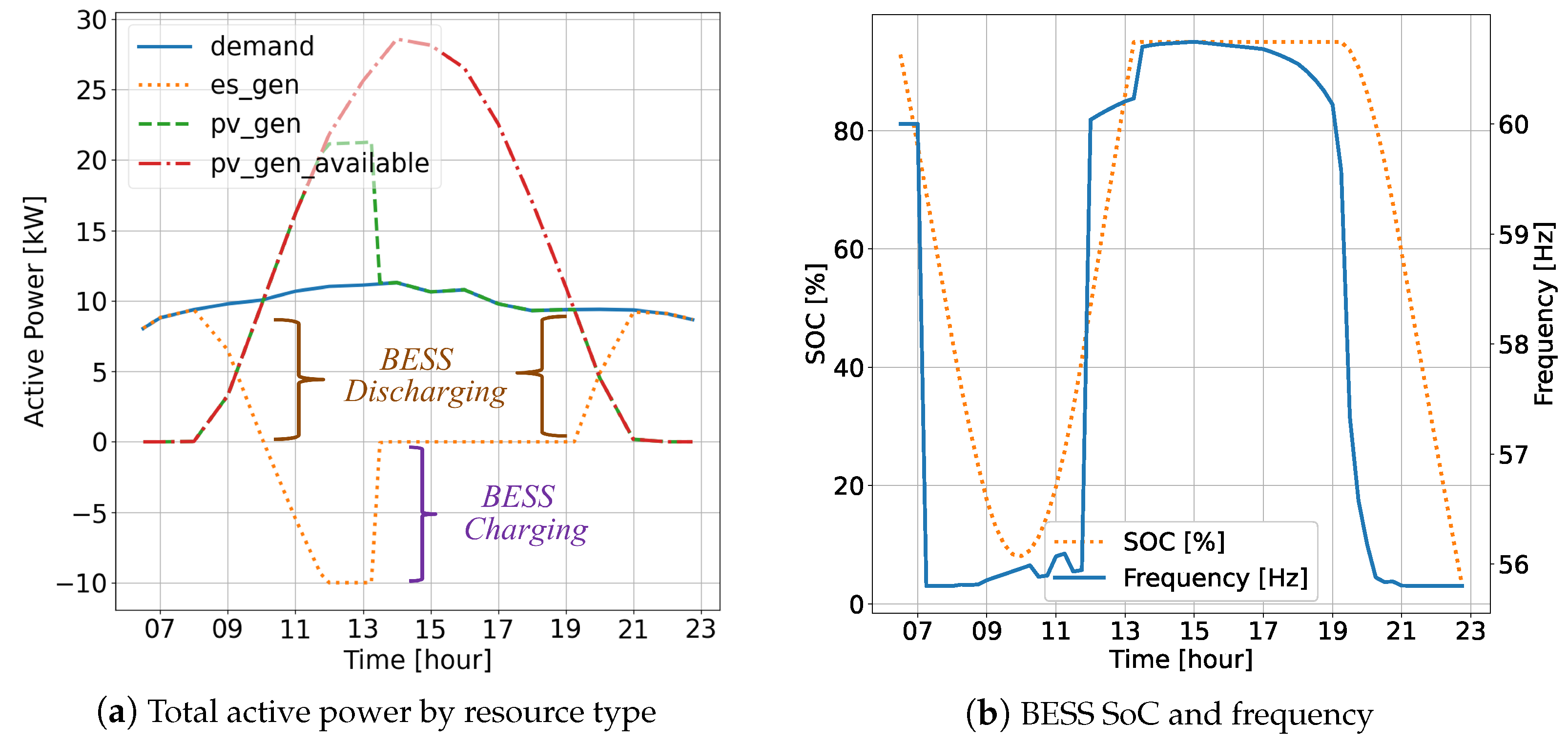


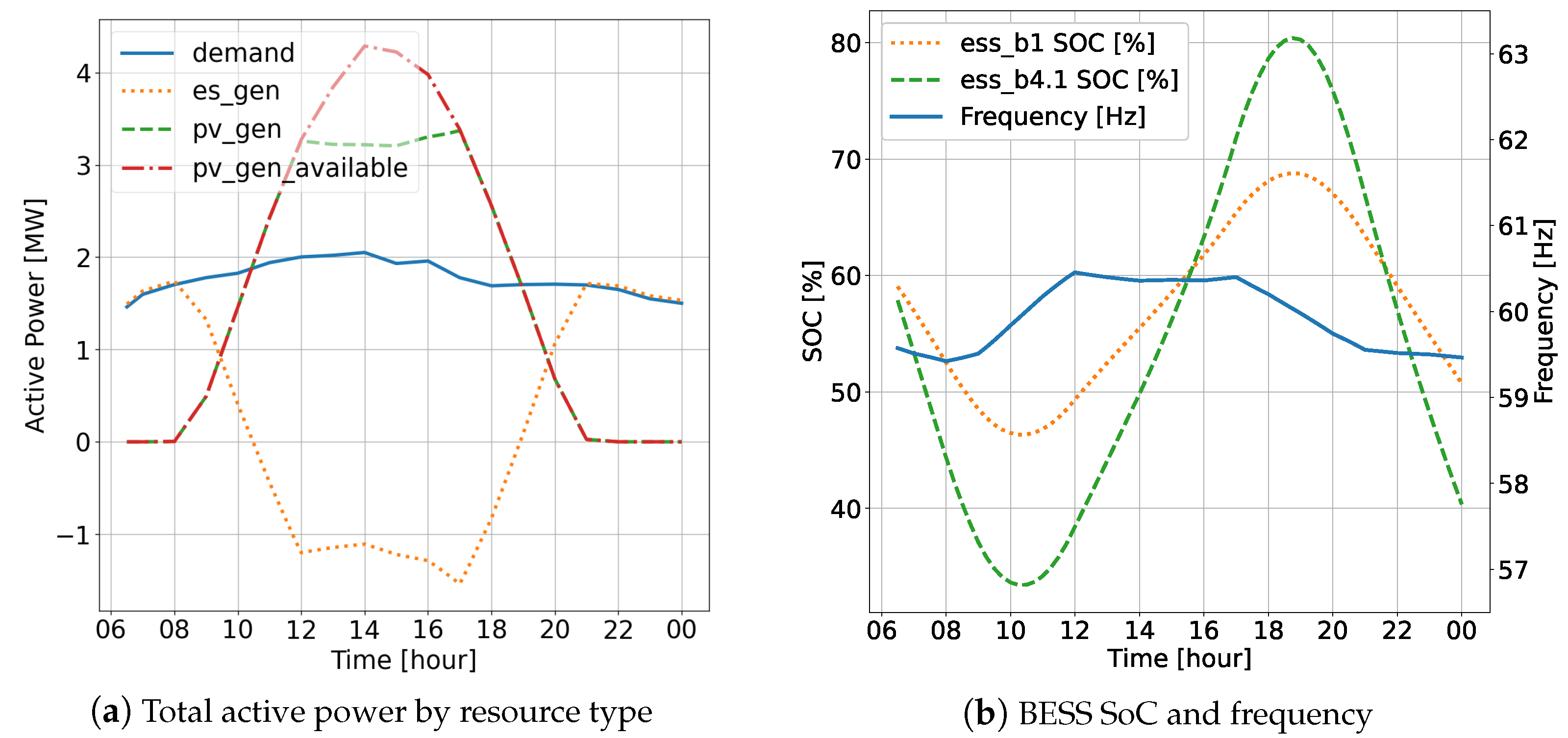
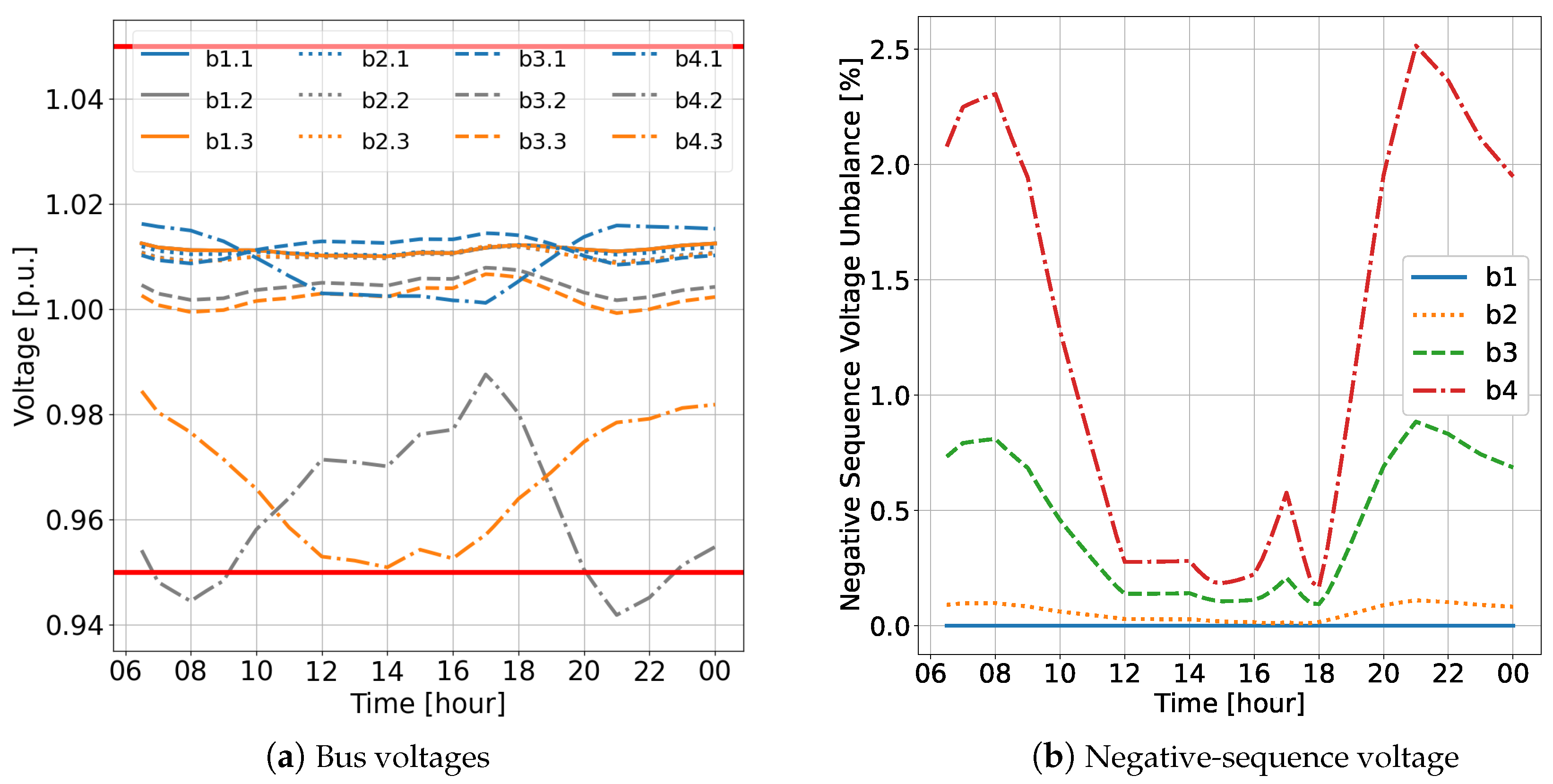
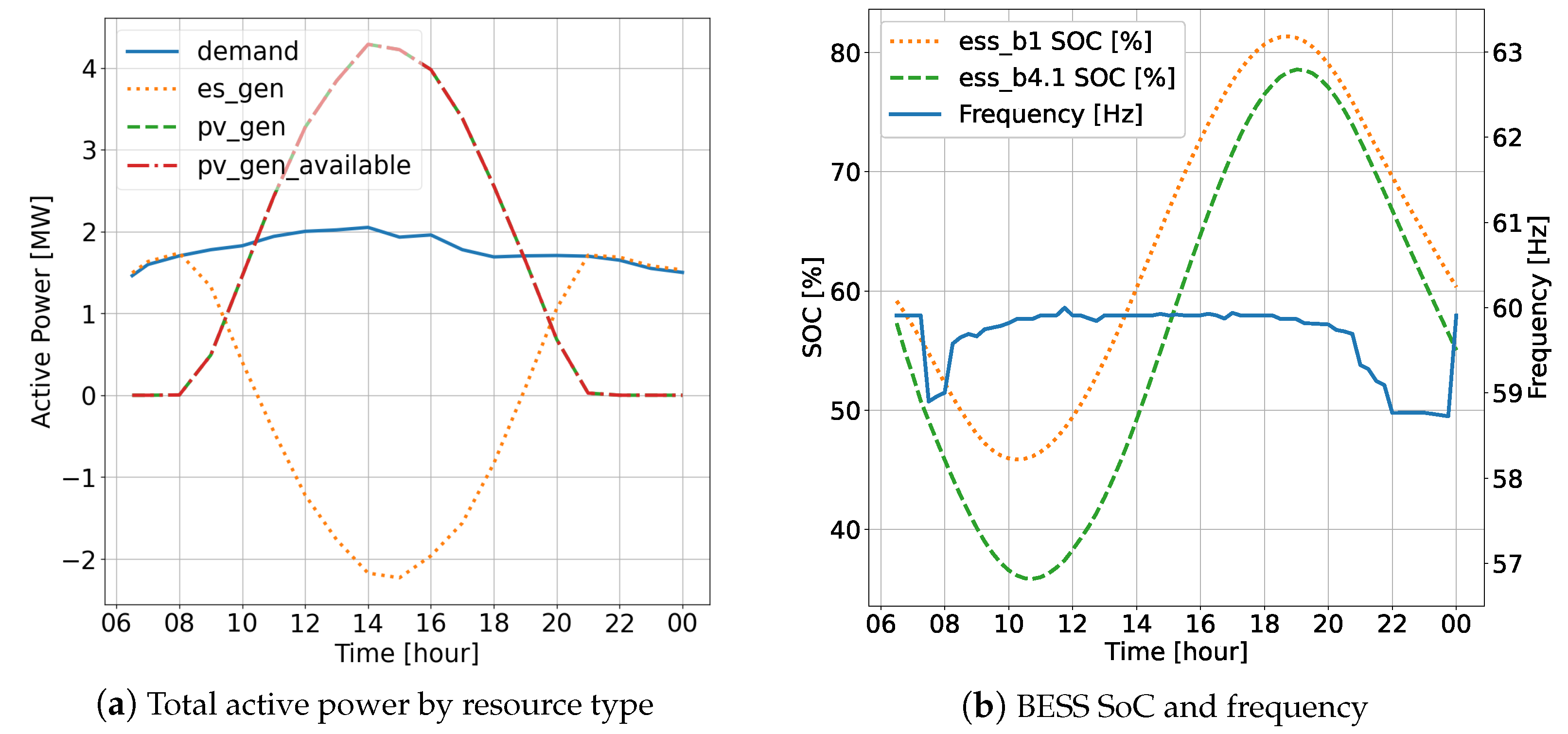

| Symbol | Description |
|---|---|
| Set of electric nodes | |
| Set of all PDEs | |
| Set of all electrical demand | |
| Set of non-controllable generators | |
| Set of controllable GFM s and the GFM which provides angle reference to the microgrid | |
| Set of controllable GFLs | |
| Set of GFM and GFL BESSs, | |
| , , , | Sets of electric nodes to which GFM s, GFL k, PDE l, and BESS e are connected |
| Parameters | Description |
|---|---|
| , | Conductance and susceptance between nodes i and j (S), respectively |
| , | Conductance and susceptance of PDE l between nodes i and j, respectively, where i, j ∈ (S) |
| System frequency setpoint for droop control (rad/s) | |
| , | Profile of available active power capacities such as SoC or irradiance of GFM s or GFL k (p.u.) |
| , , , | Droop coefficients of GFM s or GFL k, respectively (rad/(s·W), V/var) |
| , | Droop control voltage setpoints of GFM s or GFL k, respectively (V) |
| , | Active and reactive power demand d at node i, respectively (W, var) |
| , | Active and reactive power generation of non-controllable generator u at node i, respectively (W, var) |
| T | OPF planning horizon (h) |
| Initial SoC level of BESS e (p.u.) | |
| , | Lower and upper limits of SoC level of BESS e, respectively (p.u.) |
| , | Upper apparent power limits of GFM s or GFL k, respectively (VA) |
| Energy rating of ESS e (kWh) | |
| , | Lower and upper voltage limits at node i, respectively (V) |
| , | Lower and upper frequency limits, respectively (rad/s) |
| Upper current limit of PDE l (A) | |
| Target SoC level of ESS e (p.u.) | |
| , , , | Target active and reactive power dispatches of GFM s or GFL k (W or var) |
| Cost or penalty of operating BESS e at a mismatched SoC level rather than the target level (USD) | |
| , , , | Cost or penalty of operating GFM s or GFL k at mismatched power levels (USD/VA2) |
| Variable | Description |
|---|---|
| System frequency (rad/s) | |
| , | Voltage magnitude and phase angle of node , respectively (V, rad) |
| , | Active and reactive power injection per phase of GFM s at node , respectively (W, var) |
| , | Active and reactive power injection per phase of GFL k to node , respectively (W, var) |
| , | Total active and reactive power injection of GFL k, respectively, calculated according to droop control (W, var) |
| , | Active and reactive power injection setpoints of GFM s, respectively (W, var) |
| , | Active and reactive power injection setpoints of GFL k, respectively (W, var) |
| , | Positive sequence voltage magnitude and phase angle of GFM s, respectively (V, rad) |
| , , | Real and imaginary components and magnitude of the positive sequence voltage of GFL k (V) |
| , | Real and imaginary components of the current injection of PDE l to the node , respectively (A) |
| SoC level of ESS e at the end of the OPF planning horizon (p.u.) |
| Circuit Components | Specifications |
|---|---|
| BESS | Rating: 10 kW, 14 kVA, 28 kWh |
| , : 0.754 rad/(s·kW) and 2.45 V/kvar | |
| Initial SoC: 100% | |
| Inverter Type: GFM | |
| PV 1 | Rating: 10 kW, 14 kVA |
| , : 0.754 rad/(s·kW) and 2.45 V/kvar | |
| Inverter Type: GFL | |
| PV2 | Rating: 20 kW, 22 kVA |
| , : 0.377 rad/(s·kW) and 2.62 V/kvar | |
| Inverter Type: GFL | |
| Loads | kVA |
| Case | (kW) | (kvar) | kW Limit | kVA Limit | Constraints |
|---|---|---|---|---|---|
| 1.1 | 10 | 0 | ✗ | ✗ | Equations (1)–(4), (7), (15), (16), (35), and (39)–(41) |
| 1.2 | 10 | 0 | ✓ | ✗ | Equations (1)–(4), (7), (16), (18), (20), (35), and (39)–(41) |
| 1.3 | 10 | 10 | ✓ | ✓ | Equations
(1)–(4), (7), (18)–(21), (35), and (39)–(41) |
| Case | (kW) | (kvar) | (kW) | (kvar) | (p.u.) | (p.u.) | (p.u.) | (%) | f (Hz) |
|---|---|---|---|---|---|---|---|---|---|
| 1.1 | 2.51 | 5.77 | 12.51 | 5.49 | 0.9411 | 0.9420 | 0.9440 | 97.76 | 59.6987 |
| 1.2 | 5.01 | 5.67 | 10.00 | 5.59 | 0.9422 | 0.9416 | 0.9430 | 95.53 | 59.3988 |
| 1.3 | 5.02 | 1.46 | 10.00 | 9.80 | 0.9851 | 0.9857 | 0.9875 | 95.52 | 59.3980 |
| Case | f | ||||||||
|---|---|---|---|---|---|---|---|---|---|
| 1.1 | 0.001 | 0.009 | 0.004 | −0.017 | 0.000 | 0.000 | 0.011 | 0.000 | 0.000 |
| 1.2 | 0.023 | 0.001 | −0.011 | −0.001 | 0.000 | 0.000 | 0.000 | −0.001 | −0.001 |
| 1.3 | 0.000 | 0.004 | 0.000 | −0.001 | −0.010 | −0.010 | −0.010 | 0.000 | −0.002 |
| Case | (kW) | (kvar) | Initial SoC (%) |
|---|---|---|---|
| 2.1 | 0 | 0 | 100 |
| 2.2 | 0 | 0 | 5 |
| 2.3 | 0 | 0 | 3 |
| 2.4 | 5 | 0 | 100 |
| 2.5 | 0 | 13 | 100 |
| Case | (kW) | (kvar) | (kW) | (kvar) | (p.u.) | (p.u.) | (p.u.) | (%) | f (Hz) |
|---|---|---|---|---|---|---|---|---|---|
| 2.1 | 7.50 | 5.57 | 7.50 | 5.68 | 0.9432 | 0.9412 | 0.9420 | 93.30 | 59.0995 |
| 2.2 | 5.01 | 5.67 | 10.00 | 5.59 | 0.9422 | 0.9416 | 0.9430 | 0.53 | 47.9777 |
| 2.3 | 5.01 | 5.67 | 10.00 | 5.59 | 0.9422 | 0.9416 | 0.9430 | −1.47 | 39.9628 |
| 2.4 | 10.01 | 5.47 | 5.01 | 5.79 | 0.9441 | 0.9407 | 0.9410 | 91.06 | 59.3989 |
| 2.5 | 7.52 | 11.96 | 7.52 | −0.69 | 1.0106 | 1.0070 | 1.0071 | 93.28 | 59.0973 |
| Case | f | ||||||||
|---|---|---|---|---|---|---|---|---|---|
| 2.1 | 0.000 | 0.004 | 0.001 | −0.004 | 0.000 | 0.000 | 0.000 | 0.000 | 0.000 |
| 2.2 | 0.003 | 0.006 | 0.000 | 0.179 | 0.000 | 0.000 | 0.000 | −0.025 | −0.001 |
| 2.3 | 0.003 | 0.026 | 0.000 | −0.025 | 0.000 | 0.000 | 0.000 | 0.006 | −0.001 |
| 2.4 | 0.000 | −0.003 | 0.001 | 0.003 | 0.000 | 0.000 | 0.000 | 0.000 | 0.000 |
| 2.5 | 0.002 | −0.033 | 0.003 | 0.000 | 0.000 | 0.000 | 0.000 | 0.000 | 0.000 |
| Circuit Components | Specifications |
|---|---|
| BESS_1 | Rating: 10 MW, 7 MVA, 28 MWh |
| , : 1.508 rad/(s·MW) and 146.96 V/Mvar | |
| Initial SoC: 60% | |
| Inverter Type: GFM | |
| Location: Phase A, B, C of Bus 1 | |
| PV_1 | Rating: 4.5 MW, 5 MVA |
| , : 1.676 rad/(s·MW) and 110.20 V/Mvar | |
| Inverter Type: GFL | |
| Location: Phase A, B, C of Bus 4 | |
| BESS_2 | Rating: 2 MW, 2.5 MVA, 5 MWh |
| , : 3.770 rad/(s·MW) and 160.12 V/Mvar | |
| Initial SoC: 60% | |
| Inverter Type: GFL | |
| Location: Phase A of Bus 1 |
Disclaimer/Publisher’s Note: The statements, opinions and data contained in all publications are solely those of the individual author(s) and contributor(s) and not of MDPI and/or the editor(s). MDPI and/or the editor(s) disclaim responsibility for any injury to people or property resulting from any ideas, methods, instructions or products referred to in the content. |
© 2023 by the authors. Licensee MDPI, Basel, Switzerland. This article is an open access article distributed under the terms and conditions of the Creative Commons Attribution (CC BY) license (https://creativecommons.org/licenses/by/4.0/).
Share and Cite
Siratarnsophon, P.; Kim, W.; Barry, N.; Chatterjee, D.; Santoso, S. Optimal Power Flow for Unbalanced Three-Phase Microgrids Using an Interior Point Optimizer. Energies 2024, 17, 32. https://doi.org/10.3390/en17010032
Siratarnsophon P, Kim W, Barry N, Chatterjee D, Santoso S. Optimal Power Flow for Unbalanced Three-Phase Microgrids Using an Interior Point Optimizer. Energies. 2024; 17(1):32. https://doi.org/10.3390/en17010032
Chicago/Turabian StyleSiratarnsophon, Piyapath, Woosung Kim, Nicholas Barry, Debjyoti Chatterjee, and Surya Santoso. 2024. "Optimal Power Flow for Unbalanced Three-Phase Microgrids Using an Interior Point Optimizer" Energies 17, no. 1: 32. https://doi.org/10.3390/en17010032






